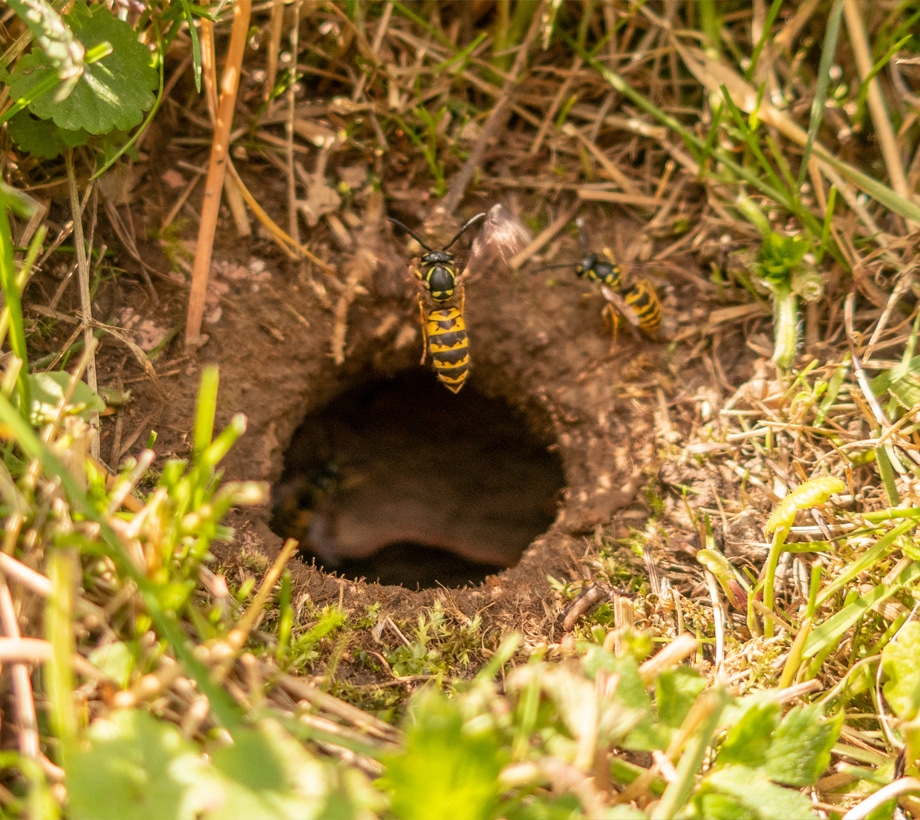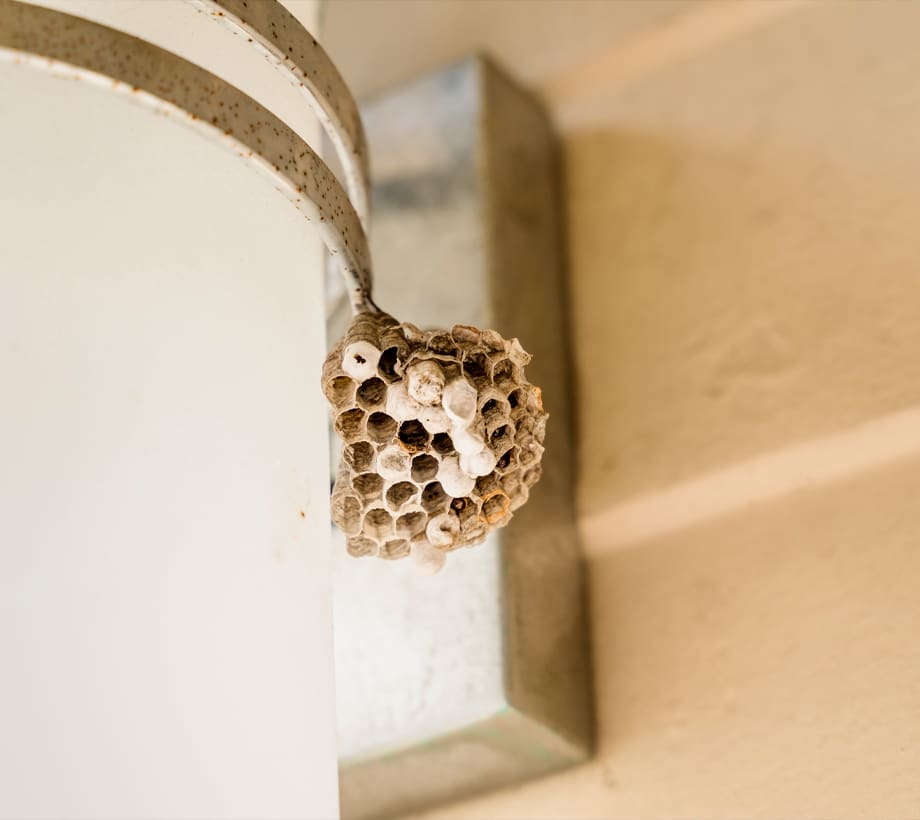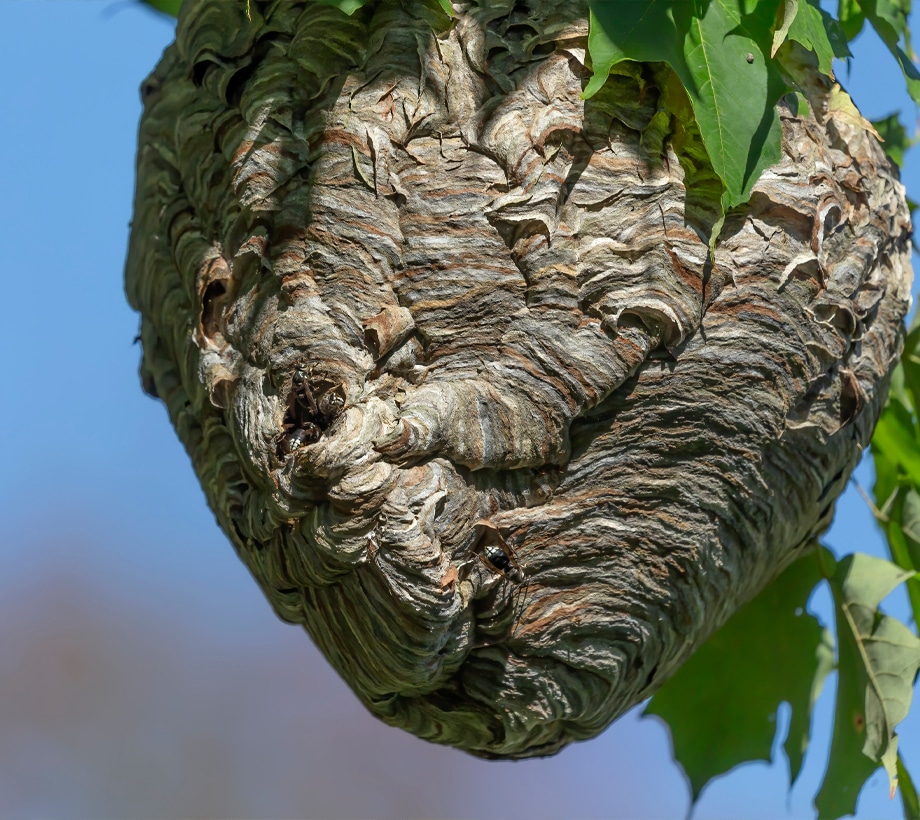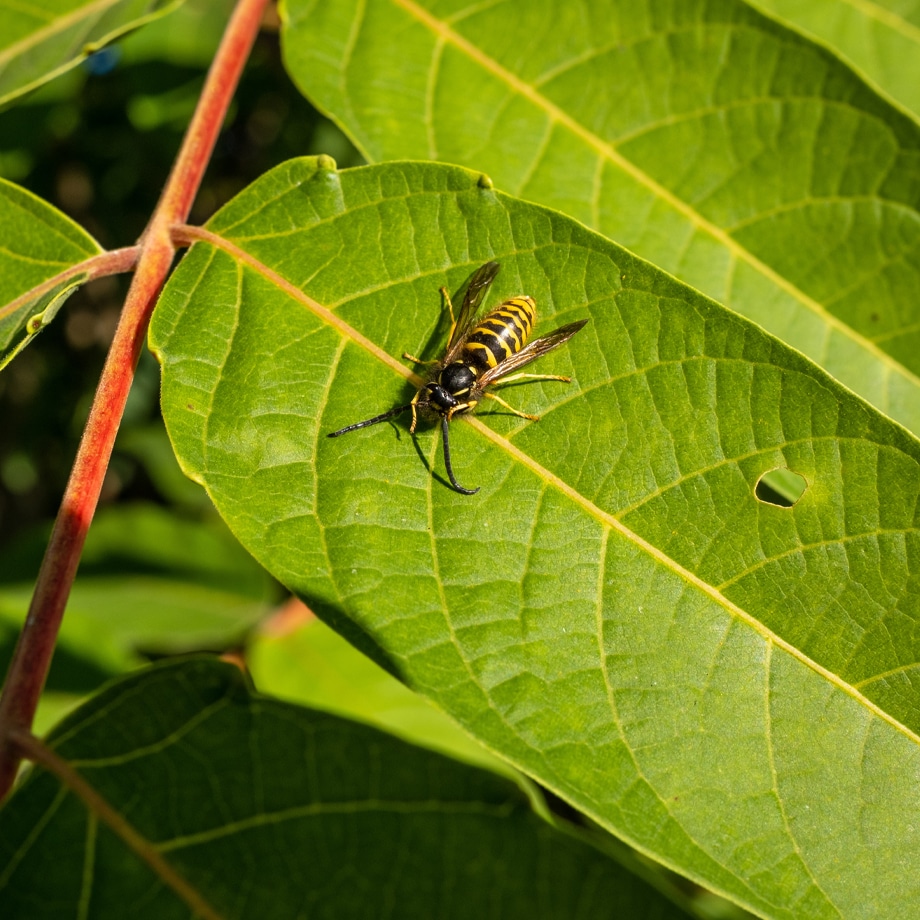
Eradicating Wasps, Hornets, and Yellowjackets in Michigan
Don’t let your summer outdoors be ruined by the presence of aggressive stinging insects. Hornets, wasps, and yellowjackets are the most common stinging pests in Michigan, besides bees. Yellowjackets and hornets are generally much more aggressive than bees and they pose a real risk to humans with their venomous stings. Thousands of people are killed every year in the United States due to allergic reactions to hornets and wasps. Like bees, these pests can build their nests in trees, under eaves, behind the siding of your home or business, underground, and in other unwanted locations. Whether it’s paper wasps, yellowjackets, bald-faced hornets, or anything else that stings, Creature Control can take care of them.
Wasps, Hornets, and Yellowjackets Facts

Wasps
There are more than 30,000 identified wasps throughout the world and they are divided into two groups: social and solitary. Social wasps (those who form colonies) account for about 1,000 species while the remainder is independent. Solitary wasps include some of the family’s largest members, like cicada killers and the striking blue-and-orange tarantula hawks, which can both reach about two inches in length. Social wasps use their stingers only for defense while solitary wasps use their stingers to inject venom into their prey while hunting. The most common wasps found in Michigan are the mud dauber wasp and the paper wasp. Yellowjackets are also wasps, but since there are twelve types in Michigan alone, we separated this species below.
The mud dauber wasp (also known as a mud wasp or a dirt dauber) are easily identifiable by the mud nests they build, which in Michigan are usually found on the walls of garages, under eaves and in cracks and corners. The nests are composed of a series of cylindrical cells that are smoothed over to form a lemon-sized nest. Dirt dauber wasps are solitary wasps and are rarely aggressive, though they will sting if insistently provoked. Mud dauber nests can last for many years if left undisturbed and may be reused by other types of wasps. Dirt daubers are predators and they prey on spiders; their natural prey are the black and brown widow spiders.
Paper wasps are about an inch long and may be brown or black with yellow spots. They take their name from their nests, which are made from plant stem pieces and fibers of deadwood mixed together with the wasp’s saliva to form a brown paper-like material from which they construct their nests. These nests are made up of several open combs with cells where their young are raised, all connected to a single, thin stalk that anchors the nest. Paper wasps build nests under any horizontal surface and are often found on tree branches, overhangs, eaves of buildings, beams and supports in attics, garages, barns, and other similar places. Paper wasps are very territorial and will attack people if they believe their nest is threatened. Their stings are particularly painful and can cause an anaphylactic reaction in individuals allergic to wasp stings.

Hornets
Similar to bees, the queen hornet dominates their hive and is the only female to reproduce within it. Most other hornets are asexual female workers that perform essential community duties such as building the hive, gathering food, feeding the young, and protecting the colony. Males are few and they have only one real role, to mate with the queen. Males typically die soon after their sexual task is complete. In colder climates, hornet nests are abandoned in winter and only the new, young queen and her eggs survive the season by finding a protected area under tree bark or inside human dwellings. In the spring, the queen will start a new nest and soon, her young will become the workers that will take over the chores of the new hive, leaving the queen to manage reproduction, which she will produce more workers to expand the colony. The primary hornet found in Michigan is the bald-faced hornet.
The bald-faced hornet is the most common in Michigan and they are considered to be the state’s most aggressive stinging insect. They are identified by the white pattern on their face and are slightly smaller than a wasp measuring about 3/4 an inch. Bald-face hornets are common in both rural and urban areas and they make their homes primarily in trees. Like paper wasps, the bald-faced hornet will make paper-like nests out of wood fibers and saliva; however, the bald-face hornet nests can grow to extreme sizes, sometimes larger than a basketball. Bald-faced hornets are more aggressive than wasps or yellowjackets and they will often sting without much provocation, and like wasps, they can sting repeatedly. Because of the danger inherent in disturbing bald-faced hornets, removal of their nests should be left to pest control professionals.

Yellowjackets
Yellowjackets are commonly referred to as wasps and are regular pests throughout Michigan and the U.S. There are twelve different types of yellowjackets in Michigan and they each have different behaviors. They build their nests either in underground abandoned burrows or within wooden decks and play structures, and even within landscaping materials including brick and boulders. Yellowjackets can be unpredictable and are extremely aggressive when provoked, and their painful stings, in some cases, maybe deadly. Yellowjackets can carry anaerobic bacteria on their stingers, which they pick up from frequent visits to landfills, sewage, or manure. The sting can result in blood poisoning in the victim. If you discover a ground hive, make sure to keep all pets and children well out of harm’s way until the hive has been removed or exterminated. Because of their aggressive nature, it is best to call a pest control professional when dealing with yellowjackets. In Michigan, the German and the eastern yellowjackets are the most prevalent.
German yellowjackets are extremely common in Michigan and they have much more in common with bees than other yellowjackets. Similar to bees, yellowjackets build large complex hives in wall cavities and ceilings that can reach 12 feet in length. The most common location for these hives is on a vertical section of drywall under the attic insulation. Property owners usually discover the yellowjackets after the colony’s workers have chewed through the drywall and gotten into the living quarters; this is a natural result of hive expansion. The workers chew up the drywall and mix it with saliva to make a paper-like product used to build the hive.
Eastern yellowjackets build hives within the ground and their colonies can reach numbers upwards of five thousand. Most of these hives start as natural depressions in the soil, or old abandoned ground burrows dug by rodents and other small mammals. As the hive grows, the workers expand it further by digging through the soil around the original tunnel. This activity loosens up the soil, creating a natural sinkhole 1 to 2 feet deep and wide. If stepped on, the burrow will often collapse, resulting in an eruption of yellow jackets that swarm the surprised bystander.
Learn More About Stinging Insects in Michigan
Summer is a wonderful time of the year for outdoor activities and enjoyment, but it’s also the season when wasps, hornets, yellowjackets, and bees are out in full force. Commercial managers need to be vigilant for any nests as they can be held liable for stings that occur on the premises. Contractors too, need to be aware of their environment so that they can perform their job safely without getting hurt. Common areas for stinging insects to nest are underground, near or within wooden decks and play structures, overhangs and eves, tree branches, and even within brick fascia and landscape boulders. Whether a nest is spotted in your residential yard or commercial property, swift and decisive action is needed to prevent harm to children, pets, and others. The technicians at Creature Control will come to your home or business prepared with extension ladders capable of reaching second-story eaves and have the tools and treatments necessary to rid your stinging insect problem.
In some cases, it is possible to eradicate a stinging insect problem; in others, you may be looking at deterrence. For example, it is not difficult to exterminate a yellowjacket nest or knock down a bald-faced hornet hive. When dealing with carpenter bees, on the other hand, people often find that they need to continue getting treatments for the bees year after year because new carpenter bees continually arrive and start drilling holes in the wood siding. Similarly, there is no guarantee that eaves once cleared of wasp nests will not be settled by new colonies of wasps later in the season. We have even seen situations where a bald-faced hornet nest is removed only to have survivors from the colony start rebuilding the hive a few days later.
Creature Control may also use a pesticide gas to reach yellowjacket hives that have been made inside brick fascia and would otherwise be inaccessible to conventional sprays. * Honey bees are also a common problem during certain times of the year. However, because honey bees are vital to the eco-system, we recommend contacting a local beekeeper to live extract them and rehome their colony whenever possible. For the specifics of any stinging insect job, please call Creature Control today to speak to one of our pest control specialists.
Any stinging insect can trigger an anaphylactic reaction in a human. Anaphylaxis is an acute hypersensitivity reaction brought on by the exposure to a particular allergen, such as the venom dispensed from wasps, hornets, and yellowjackets. Approximately 1,500 people per year die from anaphylactic reactions and it’s estimated that 10 to 15% of the population may be at risk of developing anaphylaxis. It is difficult to determine if one is at risk or not since persons can develop anaphylaxis over time; a person who was not allergic to bee and wasp stings as a youth may become so as they get older. Whenever you are stung by a wasp or bee, monitor your condition carefully and always be prepared to seek medical attention if circumstances warrant it. Signs of an anaphylactic reaction are hives or rashes on the skin, shortness of breath, abdominal pain, light-headedness, and sweating. If you think you have an anaphylactic reaction, seek medical attention immediately.
If you get stung by a wasp or hornet, provided you are not allergic and are not in danger of anaphylaxis, follow these simple steps:
- Check to see if the wasp’s stinger is still in your skin. Wasps will not leave their stingers behind unless they have been swatted and the stinger breaks off. If the stinger is embedded within your skin, use a pair of tweezers to remove it.
- Cover the affected area with ice wrapped in a towel or a bag of frozen vegetables. Do not put ice directly on the skin, as this can cause an ice burn. Leave the ice in place for five minutes; this will reduce blood flow to the affected area and slow the defensive reaction of your body against the venom.
- Ibuprofen or acetaminophen helps reduce pain. Calamine lotion can be applied to the affected area throughout the day to reduce itching. It is important not to itch or scratch the affected area, as this will spread the venom and slow the healing process. Benadryl is also helpful, either taken orally or applied topically to the sting.
- One effective Native American remedy for wasp stings is to apply mud to the affected area for about 15 minutes. The mud helps to draw the venom out of the skin.